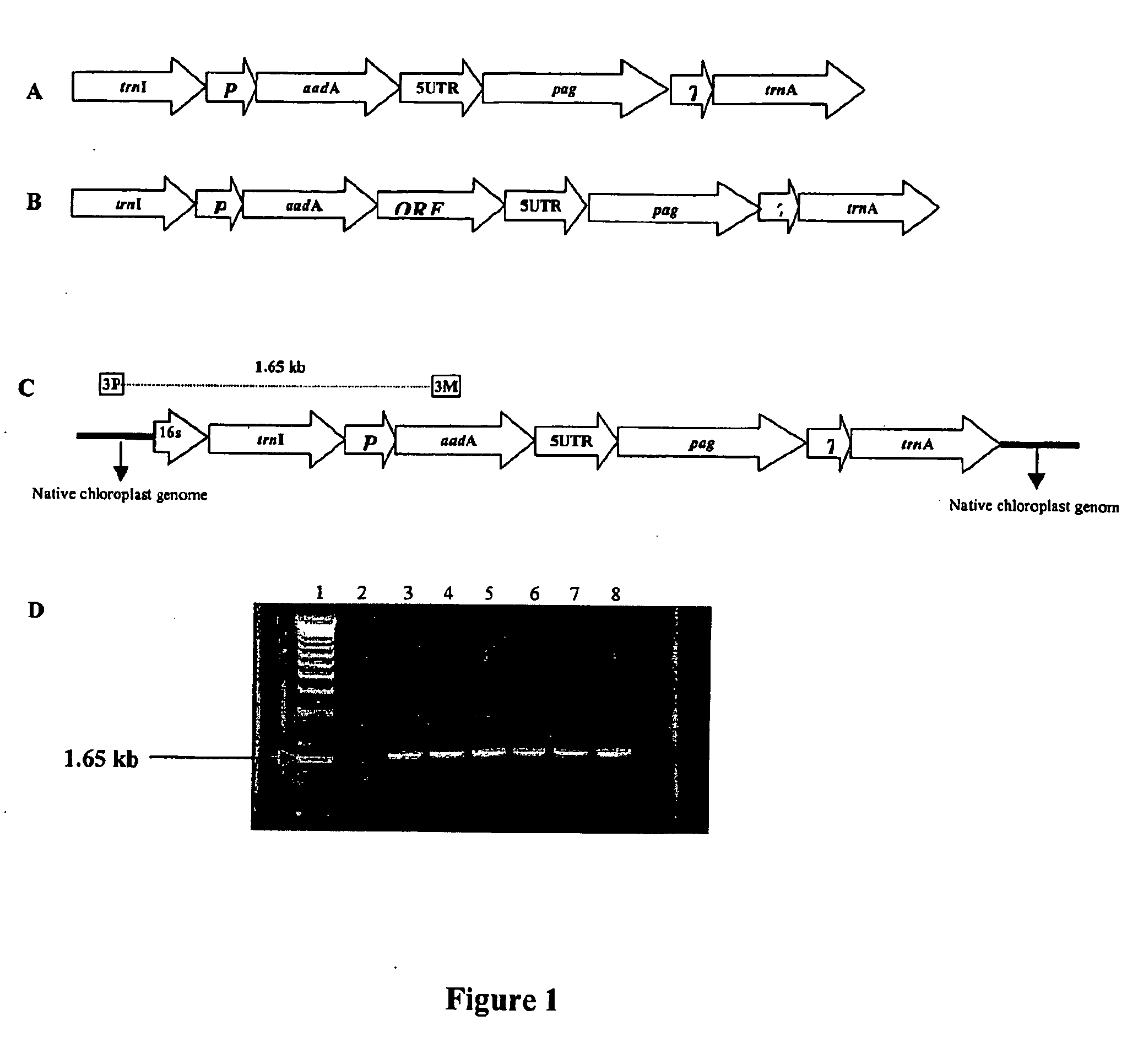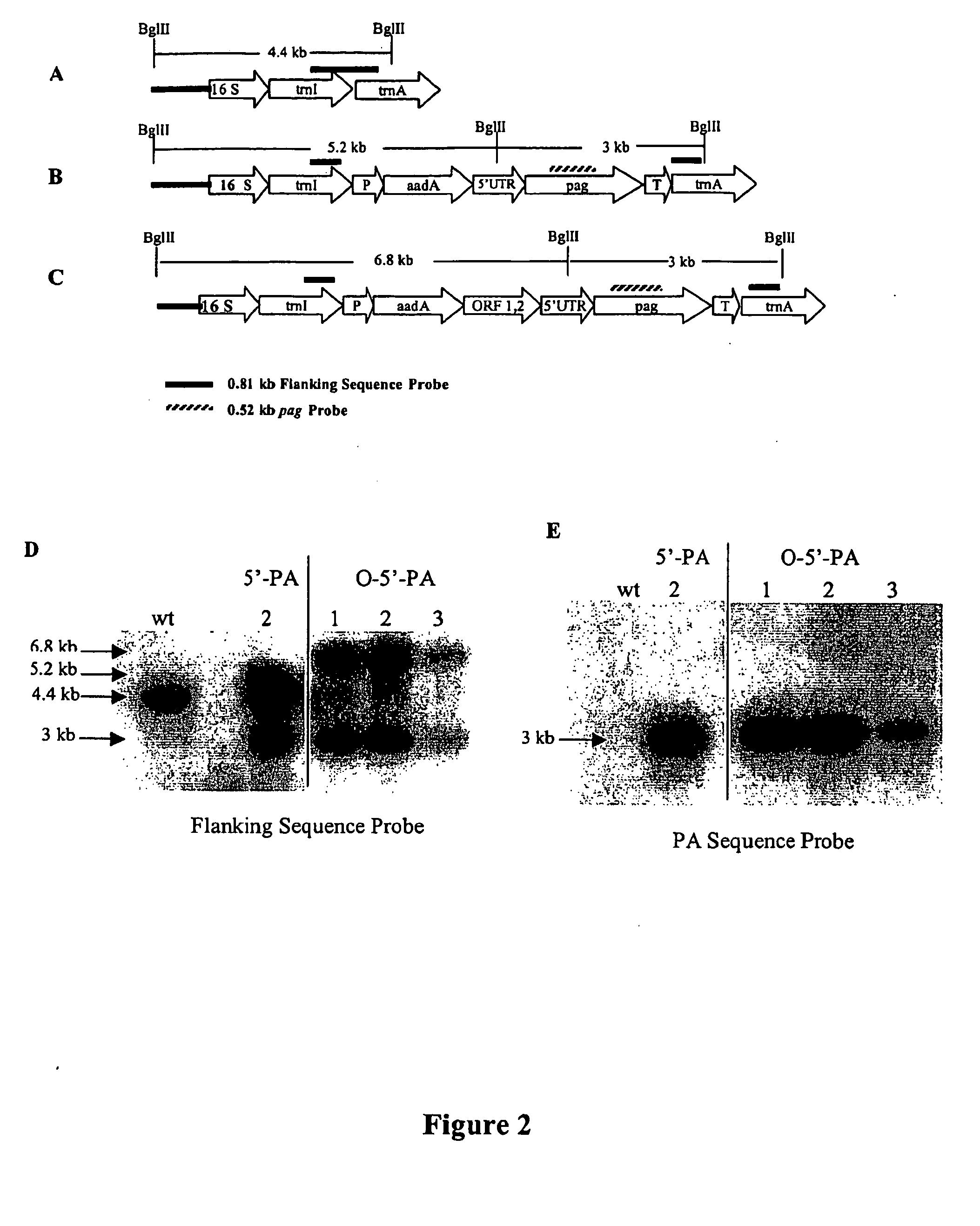Expression of protective antigens in transgenic chloroplasts and the production of improved vaccines
a technology of protective antigens and chloroplasts, which is applied in the field of expression of protective antigens in transgenic chloroplasts and the production of improved vaccines, can solve the problems of particular challenge for vaccine developers, particularly devastating plague form, and immunization against aerosolization
- Summary
- Abstract
- Description
- Claims
- Application Information
AI Technical Summary
Benefits of technology
Problems solved by technology
Method used
Image
Examples
example 1
Experiment Protocol for Example 1
Bombardment and Selection of Transgenic Plants:
[0072] Sterile Nicotiana tabacum cv. Petit Havana tobacco leaves were bombarded using the Bio-Rad PDS-1000 / He biolistic device as previously described. The bombarded leaves were placed on RMOP medium containing 500 μg / ml spectinomycin for two rounds of selection on plates and subsequently moved to jars of MSO medium containing 500 μg / ml spectinomycin.
PCR Analysis to Test Stable Integration:
[0073] DNA was extracted from tobacco leaves using Qiagen DNeasy Plant Mini Kit available from Qiagen, Valencia, Calif. PCR was performed using the Perkin Elmer Gene Amp PCR System 2400 (available from Perkin Elmer, Chicago, Ill.). PCR reactions contained template DNA, 1×Taq buffer, 0.5 mM dNTPs, 0.2 mM 3P primer, 0.2 mM 3M primer, 0.05 units / μl Taq Polymerase, and 0.5 mM MgCl2. Samples were run for 30 cycles as follows: 95° C. for 1 min, 65° C. for 1 min, and 72° C. for 2 min with a 5 min ramp up at 95° C. and a ...
example 3
Transformation of Carrot to Produce Anthrax Vaccine
[0091] Carrot (Daucus carota L.) is a biennial plant grown for its edible taproot. It is one of the most important vegetables used worldwide for human consumption. Carrot taproots are rich in vitamin A and fiber and are ideal to genetically manipulate in the chromoplast for the production of edible vaccines. For transformation of carrot, flanking sequences (trnI and trnA) are amplified with the help of PCR. Duration for regeneration of carrot plantlets is shortened to four months from eight months when replacing the antibiotic selection with BA. The same chloroplast constructs as described above for tomatoes are used for carrot except that homologous recombination regions i.e. trnI and trnA are derived from carrot chloroplast DNA. The advantage of using carrot is that from small clusters of cells or a small piece of carrot one can get thousands of transgenic plants in a limited space. Moreover, single cells are directly in contact...
example 4
Construction for the F1V Fusion Protein (the Plague Antigen)
[0094] The production of Yersinia pestis vaccine in a low nicotine strain of tobacco (LAMD) is accomplished by expressing in chloroplasts the F1-V antigen fusion protein produced from F1 gene (513 bp / 15.5 kDa) and the entire V antigen (980 bp / 35 kDa). The entire immunogenic sequence will be (441 +980 +6 for a hinge=1437 bp). With the protein of 478 amino acids having a calculated mass of 53,193 and a pI of 5.1 has shown this fusion protein to be immunoprotective.
[0095] F1-V was modified to add an EcoR1 site. This fragment is cloned into the universal chloroplast vector, which has been described above, with the psbA 5′UTR upstream of the F1-V fusion. The use of the psbA 5′UTR, is not required, but it has been shown to increase expression of foreign proteins by chloroplast.
[0096] Large-scale expression of the fusion protein results in the formation of inclusion bodies as observed with several other foreign proteins expres...
PUM
| Property | Measurement | Unit |
|---|---|---|
| size | aaaaa | aaaaa |
| length | aaaaa | aaaaa |
| length | aaaaa | aaaaa |
Abstract
Description
Claims
Application Information
 Login to View More
Login to View More - R&D
- Intellectual Property
- Life Sciences
- Materials
- Tech Scout
- Unparalleled Data Quality
- Higher Quality Content
- 60% Fewer Hallucinations
Browse by: Latest US Patents, China's latest patents, Technical Efficacy Thesaurus, Application Domain, Technology Topic, Popular Technical Reports.
© 2025 PatSnap. All rights reserved.Legal|Privacy policy|Modern Slavery Act Transparency Statement|Sitemap|About US| Contact US: help@patsnap.com



